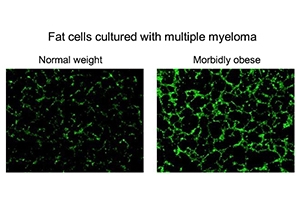Research
As Body Mass Index Increases, So Does Spread of Multiple Myeloma

In a new study published in Cancer Letters, American University researchers show how, as body mass index increases, so does the growth and spread of the blood cancer multiple myeloma, which accounts for about 10 percent of all blood cancers in patients.
“Once a person with cancer is out of the normal weight category, their BMI is contributing to multiple myeloma growth and progression,” said Katie DeCicco-Skinner, associate professor of biology at American University and lead study author.
DeCicco-Skinner and her colleagues examined the BMI of normal, overweight, obese and morbidly obese patients, and the effects on multiple myeloma. Little research into multiple myeloma examines varying patient weight to see how cells encourage cancer growth.
Even fewer studies examine cancer and the morbidly obese – a fourth weight category DeCicco-Skinner said was important to study, as more overweight individuals today have the condition.
Obesity is believed to be a risk factor for many cancers, and each 5 kg/m2 increase in BMI is associated with an increase of 10 percent in cancer-related deaths, studies show. In the multiple myeloma study, normal weight is defined as a BMI of no more than 25 kg/m2, and morbidly obese is in the range of 35 to 40 kg/m2.
Cultivating stem cells
The researchers obtained stem cells from the discarded fat of liposuction patients who underwent elective surgery. They turned them into fat cells and cultured the fat cells with multiple myeloma. In bone marrow, where multiple myeloma often takes root, fat cells play an important role in the proliferation, survival, progression and drug resistance of the cancer cells.
As a patient’s BMI increases, fat cells communicate with multiple myeloma cells, researchers found. Fat cells grow larger, gain additional lipid and secrete proteins linked to cancer. The researchers also found a correlation between BMI and angiogenesis and adhesion, key indicators of progression.
“We know multiple myeloma cells will anchor into bone marrow, and fat cells in the bone marrow will support the growth and spread of the cancer. In our study, as BMI increased, we started seeing an increase in the ability of multiple myeloma cells to adhere, which causes the cancer to better anchor,” DeCicco-Skinner explained. “With angiogenesis, cancer cells cannot exist without their own blood supply. We also found the amount of blood vessels that developed was directly proportional to a patient’s BMI.”
DeCicco-Skinner and her colleagues assumed cancer proliferation would benefit from higher-than-normal BMI because of the epidemiological link between obesity and cancer. But the relationship between multiple myeloma and the BMI of obese and morbidly obese patients was drastic.
“We found that fat cells from obese or morbidly obese patients secreted a high amount of inflammatory proteins, which contributed to tumor progression,” DeCicco-Skinner said.
Implications for treatment
DeCicco-Skinner’s research suggests a new approach for the treatment of multiple myeloma. Physicians may want to consider tailoring drugs based on a patient’s BMI because a drug may not be as effective in obese or morbidly obese patients.
“Most people think if you develop multiple myeloma, you go to the doctor, find out what the most effective drug cocktail is and how it will affect you,” DeCicco-Skinner said. “A patient may need to receive drugs to block inflammatory or other obesity-specific proteins, in addition to standard anti-cancer drugs they receive.”
Whether investigating fat cells, immunotherapy or use of the CRISPR-Cas 9 gene-editing tool, which a federal panel recently approved for a select number of patients suffering from three types of cancers, including multiple myeloma, approaches beyond attacking cancer cells are needed in the fight against many cancers. With multiple myeloma, most patients live four to seven years from their date of diagnosis, and most become resistant to chemotherapy drugs over time.
“Obesity increasingly plays a role in cancer cases as the numbers of those who are obese rise. Improving our understanding of how fat cells and cancer cells communicate with each other, and how the communication changes during obesity, is critical,” DeCicco-Skinner said.
